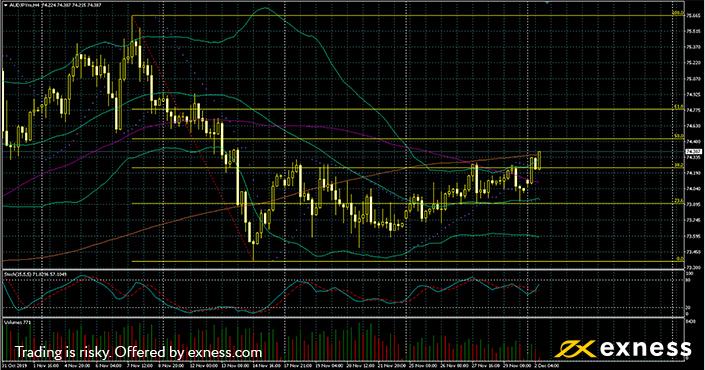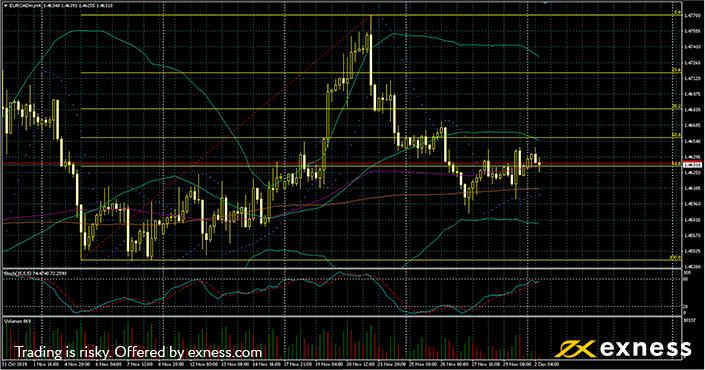The following article was submitted by Michael Stark, market analyst at Exness.
Asian markets started the week on a fairly positive note as Chinese factories posted three-year record growth in November. Caixin manufacturing PMI came in at 51.8 in the early morning today, beating both the previous release and the consensus.
Meanwhile data from Turkey was also quite strong this morning. Annual GDP growth for Q3 rebounded to 0.9% from negative 1.6%, the latter figure itself revised upward. This is the first positive release for a year and might indicate that Turkey’s economy is recovering in earnest.
The main events this week apart from the NFP are three meetings of central banks. Firstly there’s the Reserve Bank of Australia tomorrow, then the National Bank of Poland and the Bank of Canada on Wednesday.
Non-farm payrolls are of course the focus of this week’s economic data. That said, there’s a range of other figures coming out from the USA. ISM PMI is today and Wednesday, plus there’s balance of trade for October on Thursday afternoon. The dollar will probably be quite active this week around these important releases.
Cable, four-hour
The pound has generally held with a range of about a cent since the start of last week. Expectations for the Conservatives to win a workable majority next week are holding, but until the result of the election is known for sure there probably won’t be much intensity of buying the pound. Data from the USA last week was generally better, though, so there’s also a degree of demand to buy the greenback.
1.30 remains the most important high resistance just above the top of this chart. This isn’t likely to be tested seriously anytime soon. Instead, cable will probably continue within its range more-or-less for the next few days. If we determine the current zone of free movement as between the 23.6% and 61.8% Fibonacci retracement areas, traders might wait for another candle with a long wick before selling.
Key data points
- Monday 2 December, 15.00 GMT – ISM manufacturing PMI (November): consensus 49.2, previous 48.3
- Wednesday 4 December, 15.00 GMT – ISM non-manufacturing PMI (November): consensus 54.5, previous 54.7
- Thursday 5 December, 13.30 GMT – American balance of trade (October): consensus -$49 billion, previous -$52.5 billion
- Friday 6 December, 13.30 GMT – non-farm payrolls (November): consensus 180,000, previous 128,000
- Friday 6 December, 15.00 GMT – Michigan consumer sentiment (November, preliminary): consensus 97, previous 96.8
Aussie dollar-yen, four-hour
A trade-sensitive currency, the Australian dollar has generally received some fundamental support from reports of progress towards ending the long-running dispute between China and the USA. On the other hand, AUD has been hit fairly hard this year by a combination of decreasing interest rates, reflecting challenging economic conditions in Australia, and declines in the prices of various industrial commodities such as iron ore.
The angle of the initial reaction to the latest downtrend in the first half of November suggested that a more significant bounce might have occurred than what actually happened. Nonetheless, declining volatility and attempts to move above the 200 SMA suggest that gains for the Aussie dollar might be likely on this chart.
A lot depends on the RBA tomorrow morning: no further cuts to the historic low 0.75% cash rate are expected, but comments from Governor Philip Lowe about possible future changes are key for AUD’s direction this week.
Key data points
- Tuesday 3 December, 3.30 GMT – RBA’s meeting: consensus 0.75%, current 0.75%
- Tuesday 3 December, 21.30 GMT – AIG services index (November): consensus 53.9, previous 54.2
- Wednesday 4 December, 0.30 GMT – Australian GDP growth (Q3, annual): consensus 1.7%, previous 1.4%
- Thursday 5 December, 0.30 GMT – Australian balance of trade (October): consensus A$6.1 billion, previous A$7.2 billion
- Thursday 5 December, 0.30 GMT – Australian retail sales (October): consensus 0.3%, previous 0.2%
Euro-Canadian dollar, four-hour
The Canadian dollar’s direction has generally followed that of oil as usual over the past few weeks although mixed domestic data recently has caused some reluctance among traders to get too involved. Data from the EU was somewhat better over the first few weeks of November. Overall, though, the price of oil is likely to remain the most important driver for the Canadian dollar in the runup to this week’s meeting of the BoC.
The technical picture at the moment suggests some strength for the euro against CAD. The slow stochastic has moved upward fairly consistently with limited gains in price since a classic upward crossover last week. Price remains above the 200 SMA and very slightly above the 100 SMA. The first challenge for buyers here is the 50 SMA from Bands which coincides with the 50% Fibonacci retracement area.
Wednesday and Thursday’s data are very important for whether the euro can break above 1.466. Some sudden hawkishness from Dr Poloz and the BoC, while unlikely, could mean more losses for the euro, though.
Key data points
- Wednesday 4 December, 15.00 GMT – BoC’s meeting: consensus 1.75%, current 1.75%
- Thursday 5 December, 7.00 GMT – German factory orders (October): consensus 0.3%, previous 1.3%
- Thursday 5 December, 10.00 GMT – eurozone employment change (Q3, annual, final): consensus 1%, previous 1.2%
- Thursday 5 December, 15.00 GMT – Canadian Ivey PMI (November): consensus 53.8, previous 48.2
- Friday 6 December, 7.00 GMT – German industrial production (October): consensus 0.1%, previous -0.6%
- Friday 6 December, 15.30 GMT – Canadian full-time employment change (November): consensus 20,000, previous -16,100
Disclaimer: any opinions made may be personal to the author and may not reflect the opinions of Exness or LeapRate. This is not a trading advice.



